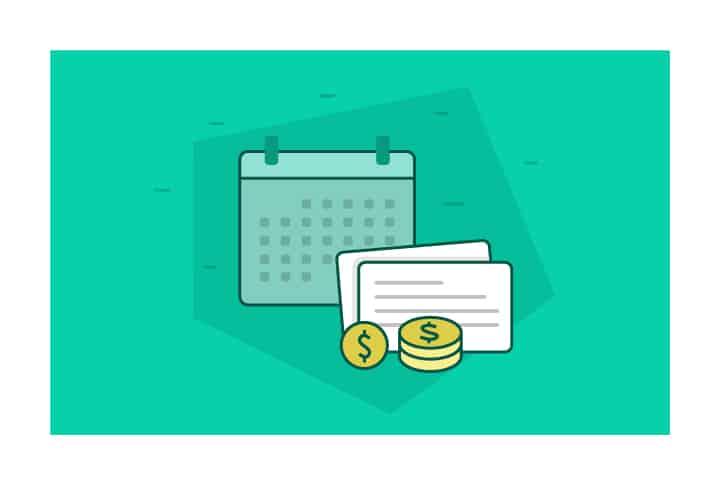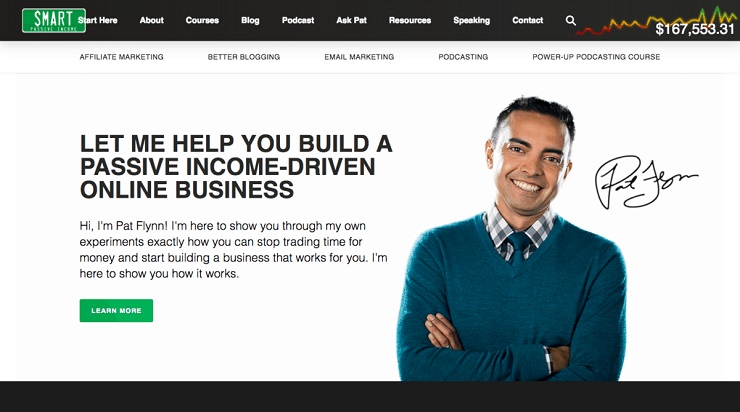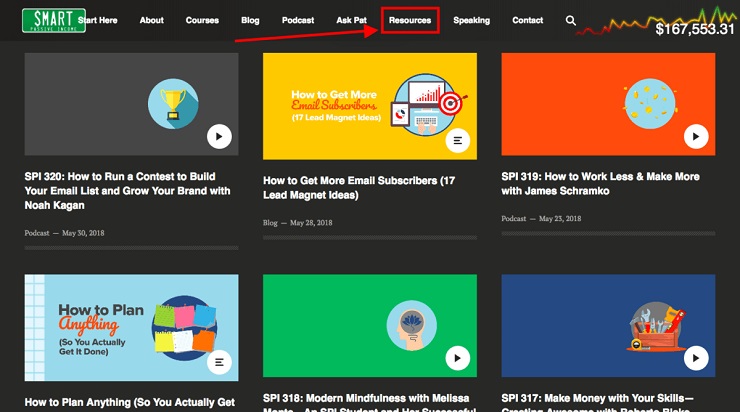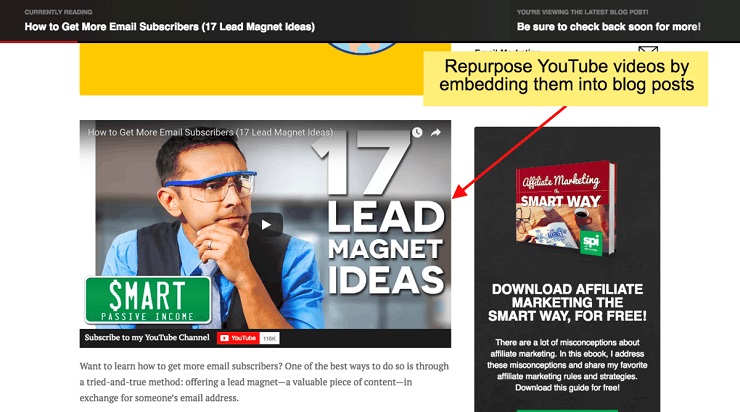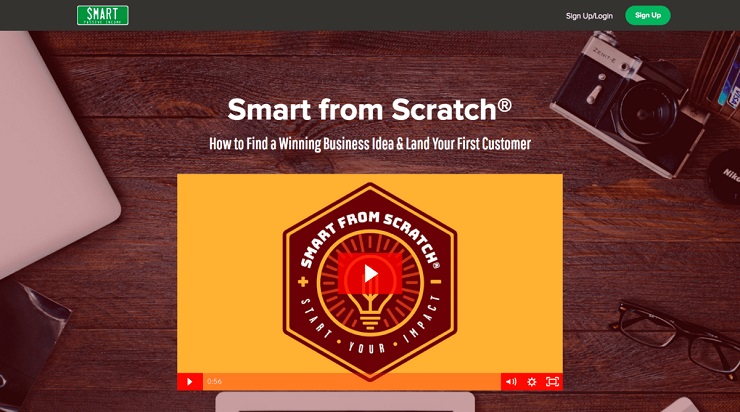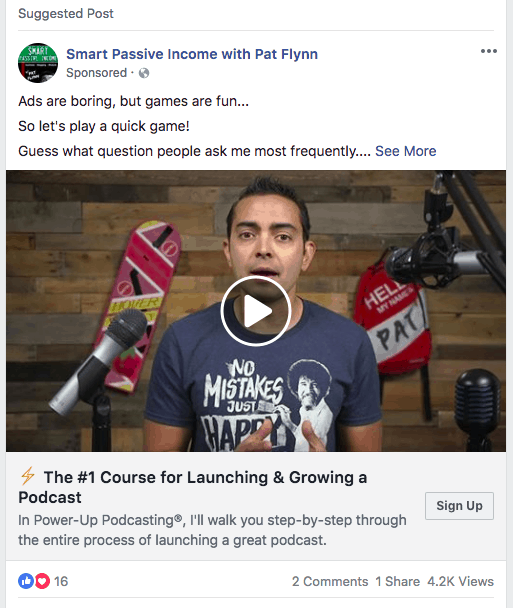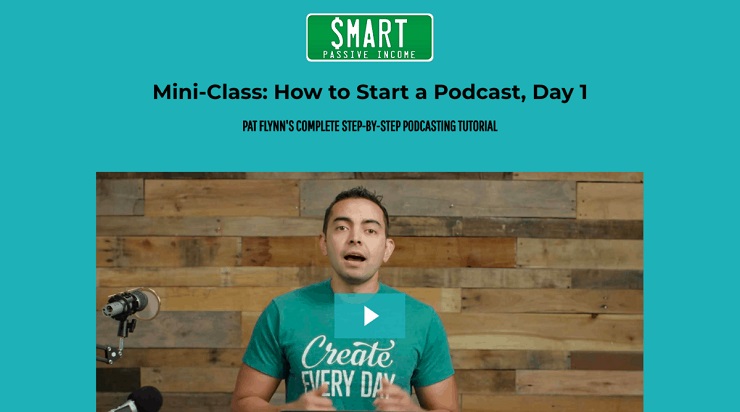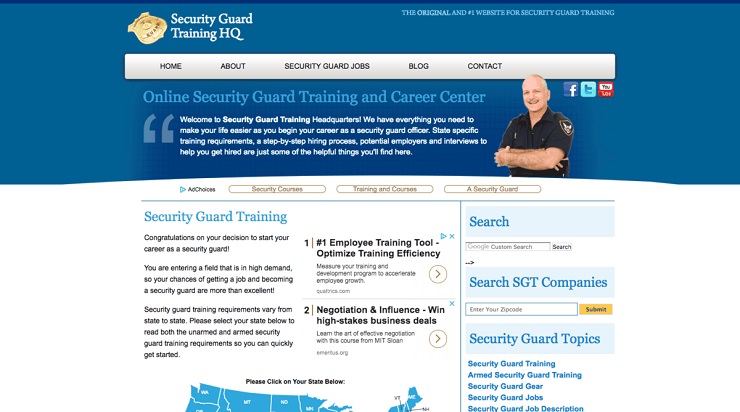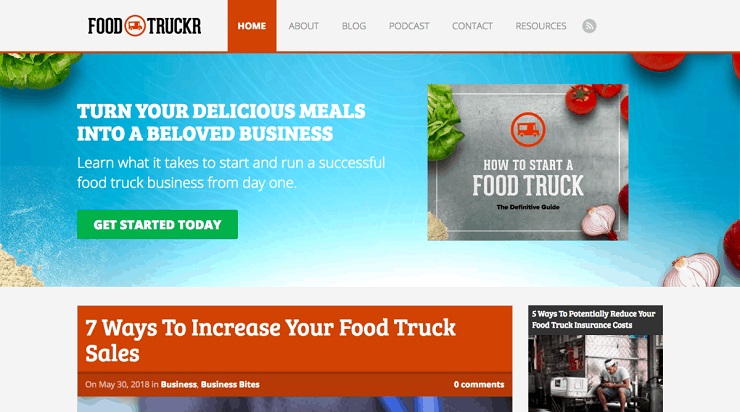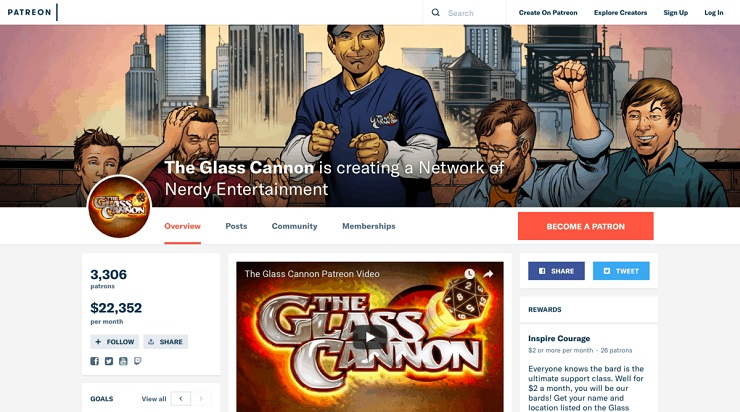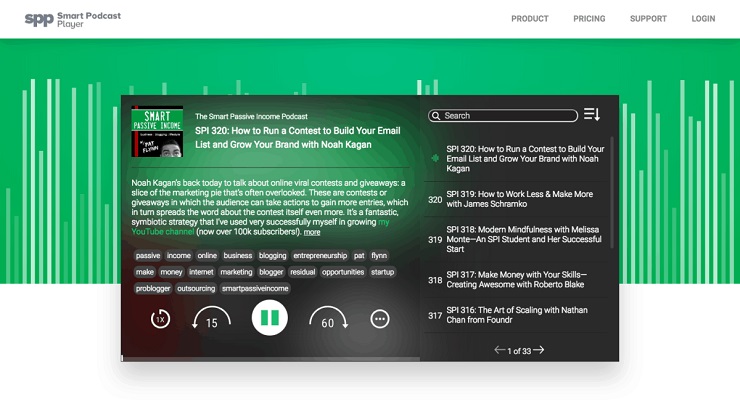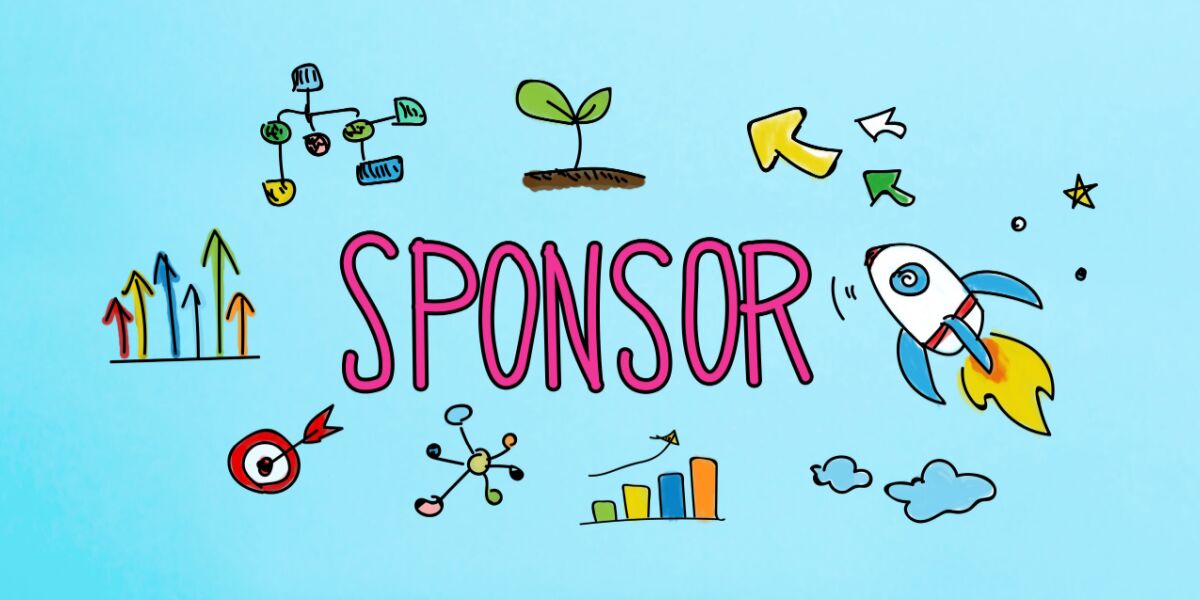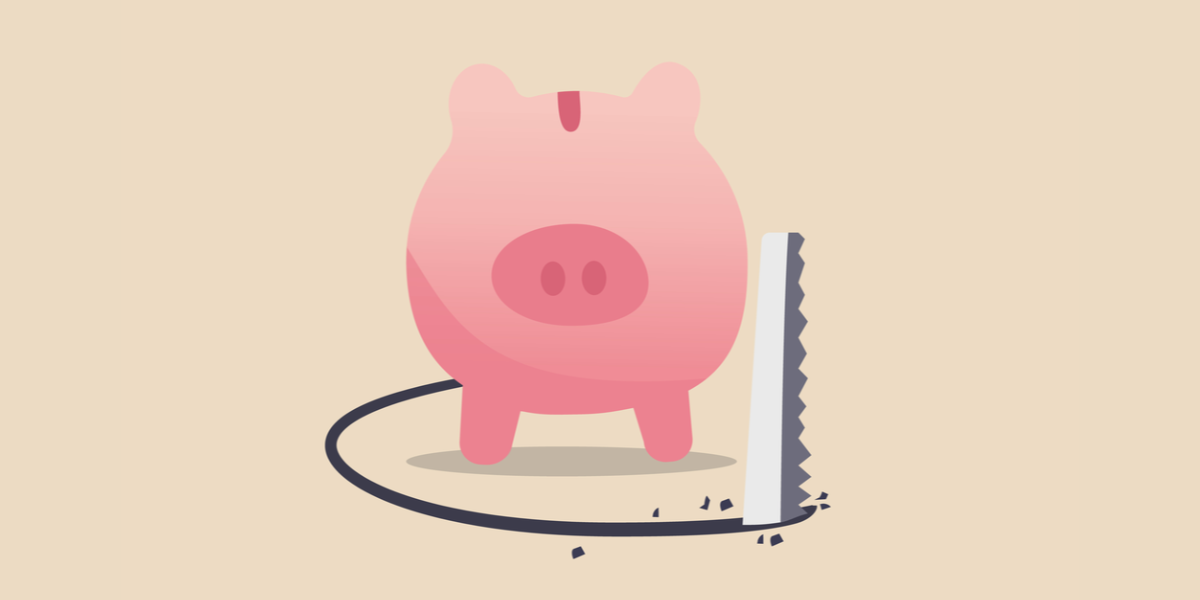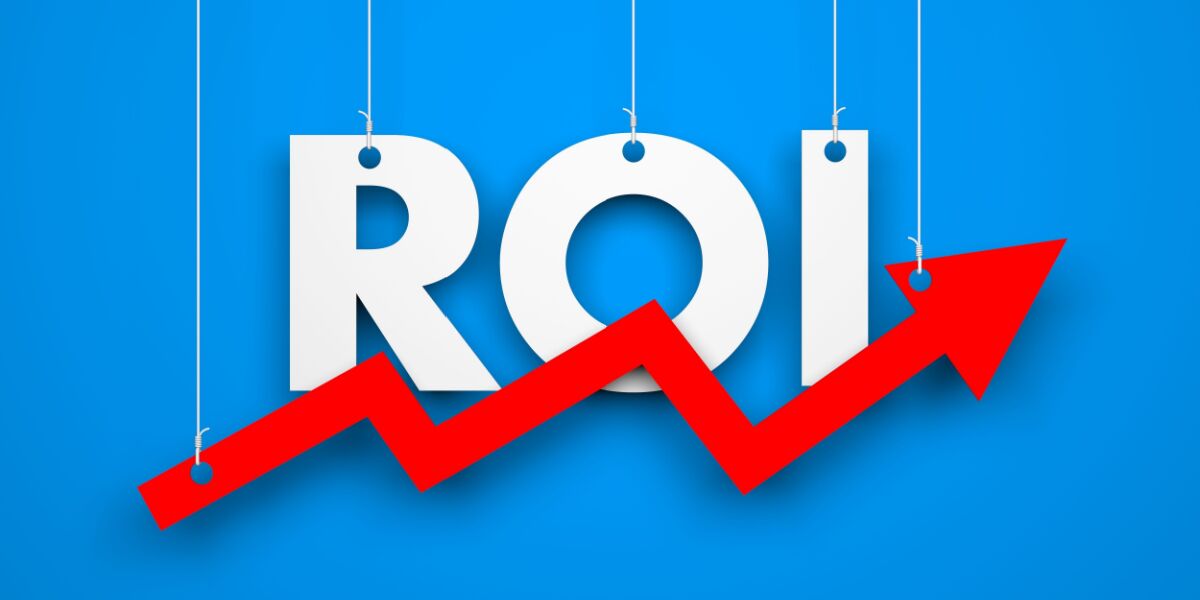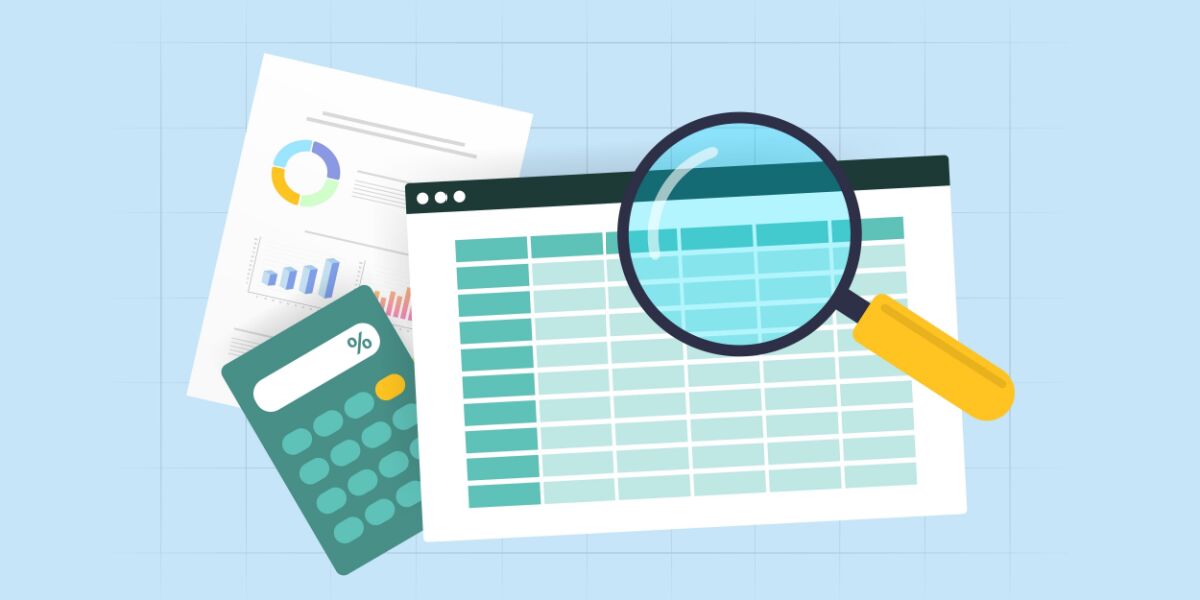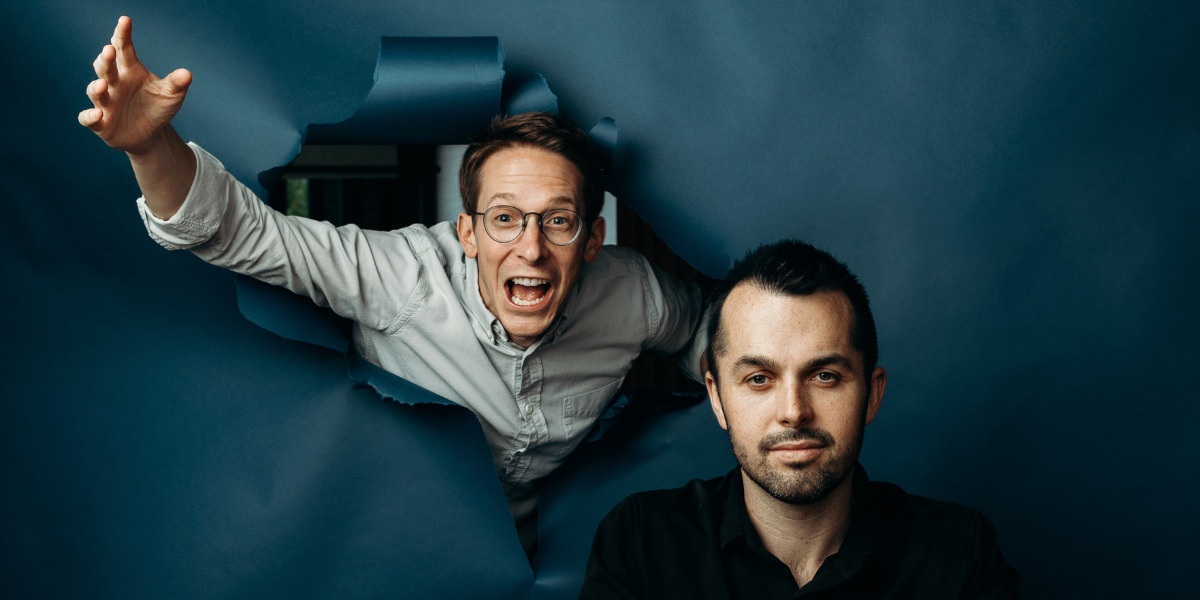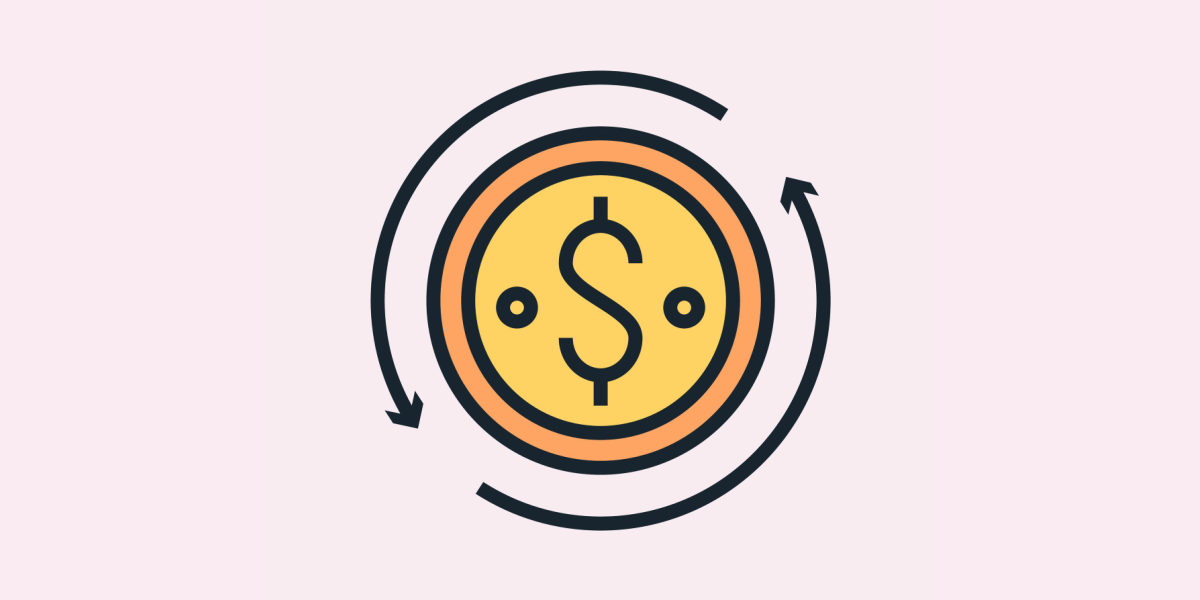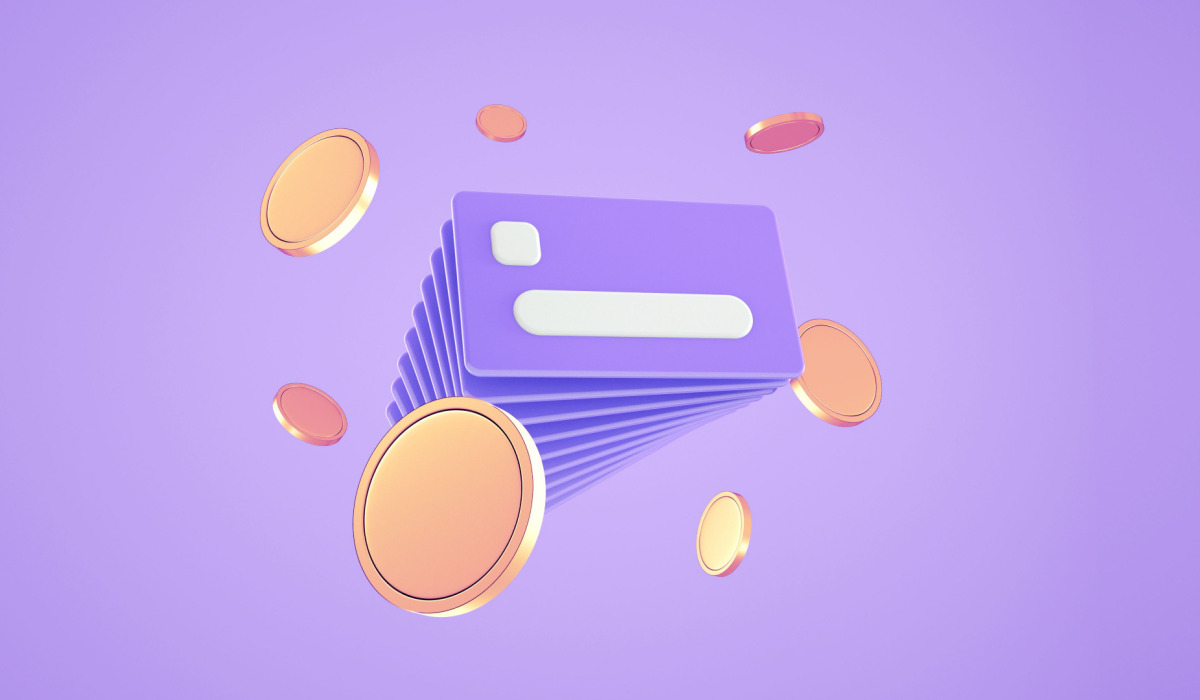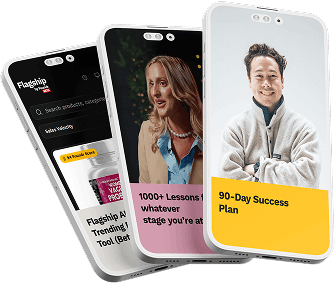It’s every entrepreneur’s dream: passive income. Elusive, challenging, and some say, impossible, generating a passive income means you can earn money while you sleep.
And if there’s one person who’s become an authority on the various passive income sources out there, it’s Pat Flynn, founder of the Smart Passive Income blog. In 2008, after getting laid off from his job, Flynn launched SPI and has been publicly sharing reports on his own adventures in passive income, in hopes of helping others achieve similar success.
While the term passive income may sound like it’s about getting something for nothing, Flynn’s not a fan of “get rich quick” schemes or unrealistic promises. He’s quick to acknowledge that making money online is hard, and that passive income requires a lot of upfront work. His first online business took about a year before it generated enough income to support his family. While there are many different definitions of passive income, Flynn’s definition is:
“Building online businesses that take advantage of systems of automation that allow transactions, cash flow, and growth to happen without requiring a real-time presence.”
So if you’re sick of trading time for money, you’re in for a treat. We asked Flynn to unpack his passive income strategies for the Foundr community, by walking us through each line of his income report from December 2017, in which he earned $167,553.31. In 2017, Flynn reports a total of $2.1 million in passive income, so this guy clearly knows his stuff. Let’s dive in!
Table of Contents
Affiliate Earnings: $105,619.13
Book Sales: $2,246.50
Course Sales: $41,849.98
Niche Sites: $3,866.96
Podcast Sponsorships: $3,389.00
Software and Apps: $10,581.74
What’s Next for Pat Flynn?
Want to Get Started Earning Passive Income? Here Are 7 Tips We’ve Learned from Pat Flynn
Affiliate Earnings: $105,619.13
Affiliate marketing is when you promote a product and receive a commission for each sale (or other conversion event) made through an affiliate link that’s unique to you. Flynn has mastered affiliate marketing, with 63% of his December 2017 income coming from this category.
Flynn earns affiliate income from the following sources:
- AWeber
- Best Year Ever by Michael Hyatt
- Bluehost
- Bonjoro
- ConvertKit
- Create Awesome Online Courses
- Leadpages
- Market Samurai
- Samcart
- Social Media Marketing World
- Teachable
- WP-Wishlist
How to Succeed at Affiliate Marketing
If you’re strapped for time and want a great introductory passive income source, affiliate marketing is the way to go. Flynn says he loves it because he could never create all these products himself, but he can still earn a commission by genuinely recommending them to his audience. But make sure that the affiliate product aligns with your audience, and if you have personal experience with the product, that’s a recipe for success.
“All the products that I promote are products that I’ve used and I know will also serve my audience,” he says. “And that’s key.”
How to Automate Your Affiliate Marketing
1. Create step-by-step guides
The main way Flynn automates income for his affiliate products is by creating step-by-step guides on his blog that walk readers through a specific process. These posts don’t directly promote a product; instead, he uses these posts as an opportunity to teach readers about a particular topic. He then links to the affiliate products he uses in the process, and thereby, earns income from helping others. A great example of this is Flynn’s “How to Build a Niche Site” series.
“Because I’m teaching, I’m not just sharing information about a product, but I’m teaching them something,” he explains, “ it doesn’t feel like a sell or a sale at all.”
In addition to recommending affiliate products in his blog posts, Flynn includes free alternatives that help achieve the same goal. Why? He sees an advantage to comparing what he calls the “free with headaches” and the “headache-free” way.
“When you show a person how to do something for free, like keyword research, for example, you can show the limitations of doing it for free,” Flynn explains. “You can show how cumbersome the process is. You can show how complicated it is versus a tool that can do that for you in a fraction of the time. People pay for time. People pay for convenience, and that’s a great way to compare and contrast.”
These in-depth how-to guides continue to pay off for years to come, because the content is evergreen and ranks well in search engines results. Flynn also makes sure to link to them in newer blog posts and mention them in his podcasts, giving his guides longevity.
2. Publish a resource page on your site
Another way Flynn automates affiliate income is through his blog’s resource page. “This is, by far, the easiest thing that any brand can do,” he says.
A resource page is a list of all of your favorite products that you recommend to your audience. This works especially well for influencer brands or experts, because your audience wants to know which tools you use.
“There’s a lot of value that comes with being the person who organizes all the information out there, including paid products,” Flynn says. “ And when those are affiliate opportunities, that’s money in your pocket over time.”
Your resource page should be displayed prominently in your site’s main navigation. See how Flynn does it below:
Further, you should include the resource page link in your email sequence, in podcasts, and other places to continue to drive traffic to it.
“The nice thing about the resource page is that people will go there, and they’ll also see other things that they didn’t know they need too,” Flynn says. “So it’s a great way to sort of expand what a person might get involved with there.”
3. Upload demonstration videos to YouTube
Again, using the opportunity to teach his audience something valuable, Flynn creates demonstration videos for his affiliate products, such as this one on ConvertKit:
Uploading these videos to YouTube has a couple of benefits:
- They get organic traffic from YouTube search. Flynn gets a lot of organic traffic for his ConvertKit video, which currently ranks very well in YouTube search results. Yep, just like you optimize your blog posts to rank well with Google, you need to optimize your descriptions on YouTube (which is owned by the search engine giant) to get your videos to rank well for certain keywords.
- They can be embedded into blog posts. By embedding video into your blog posts, you can enrich the experience for your reader and help them feel like they know you. Flynn does this in many of his blog posts, such as the one below:
Overall, think of these YouTube demo videos as a mini lesson for your viewers that just happens to have an affiliate link. “I’m teaching by showing off the tool and how it’s used and the benefits of using this tool versus those others,” Flynn says. “And when you do that and you mention an affiliate link at the end, you’re going to get people who go through your link because you’ve provided them that value.”
4. Create an email challenge
“Challenges” are popular lead magnets, particularly because they motivate participants with small wins on a daily basis. A challenge usually lasts for a few days and is automated to send an email each day with some small action for the subscriber to take to reach a specific goal by the end of it.
“People love challenges because it happens on a specific day,” Flynn explains. “They know that it’s not something they’re committing to forever, and they’re also doing it with other people, usually.”
Think of the challenge as step one in a process, says Flynn, and the affiliate product you’re promoting within it as step two. For example, he and his team created a zero-to-100 email list-building challenge for people starting their email lists from scratch.
The affiliate product he recommends in the challenge is email marketing software ConvertKit, but the challenge is not about ConvertKit. The software isn’t even mentioned until the very end of the three-day challenge. On day four, an email goes out congratulating subscribers on reaching the end, and then he mentions next steps and how they can use ConvertKit to systematize their email marketing.
Flynn put a lot of work into creating the challenge and launched it live (it wasn’t automated at first). But once he saw the success of it, he was able to reuse and automate the content. Now it’s an evergreen challenge anyone can sign up for.
To drive traffic to his challenge opt-in form, he mentions the URL on his podcast, blog, YouTube, and social media, creating “an automated machine that can help push these products out.”
NOTE: One way to earn passive income is to sell physical products via an online store. If you want to learn how to start & grow a profitable online store in 12 weeks or less, sign up for our FREE Masterclass below!
Learn How to Start a Profitable Store in 12 Weeks or Less. Join our FREE Ecommerce Masterclass!
Book Sales: $2,246.50
Obviously, a lot of upfront work goes into writing a book. But once it’s created, not only will your book earn passive income via sales, but it also can be used as a tool to grow your list and increase customer loyalty.
Flynn earns income from these books he’s written:
- Let Go ebook (Amazon Kindle)
- Will It Fly? ebook (Amazon Kindle)
- Will it Fly? Paperback
- Will It Fly? Audiobook
In his first book, Let Go, Flynn shares his struggles to overcome adversity on his path to becoming an entrepreneur. Though it was self-published in 2013, he’s found many ways to update and refresh the content over the years. For Flynn’s 10-year anniversary as an entrepreneur, he’s launching a Kickstarter campaign to promote the first hardcover edition of the book, with rewards such as tickets to his first in-person event in 2019. Because this book shares more of his personal life, it’s especially effective at establishing a stronger connection with his audience.
“People have reached out to me saying … that’s been a life-changing book for them,” Flynn says, “because they can relate to the story. They feel like they’re there with me and are going through the same things in their life right now.”
How Flynn Uses a Companion Course to Convert Up to 40% of His Book Readers to Email List Subscribers
His second book, Will It Fly?, walks readers through the process of validating business ideas so they don’t waste time and money pursuing a dud. That book went on to become a Wall Street Journal bestseller. It also became the launchpad for a creative lead generation strategy, which was inspired by one of Flynn’s favorite TV shows, The Walking Dead.
Before each episode of The Walking Dead starts, viewers are told to check out a certain website to get a behind-the-scenes look at the show. Jumping off of that idea, Flynn decided he wanted to do something similar with his book by creating a companion course for Will It Fly?
Here’s how he did it: Using online course platform Teachable, Flynn created lessons to match each chapter of his book. Each lesson contains all the links he mentioned in that book chapter, plus videos, high-res images, and bonus materials so readers can dive deeper into the book’s content. That companion course converts a whopping 35% to 40% of his readers into email subscribers.
How to Use Your Book as a Launching Point for an Online Course
After completing the companion course for Will It Fly?, many students reached out to Flynn asking for even more help.
“They want more detail even beyond the companion course that I gave them,” he says. “They wanted accountability. They wanted community.”
After listening to his audience, Flynn decided to beta test his first full-fledged online course, which would go into more detail about the process he writes about in his book, with more examples, accountability from Flynn himself, and the company of other students.
To validate his course idea, he set a goal of getting 100 students from the companion course to sign up for the paid beta. If he didn’t reach that number, he decided, he would cancel his plans and refund their money. This is the same process he recommends in his book: Ask people for payments upfront, and then go build your product once your idea is validated.
So Flynn pre-sold his online course, Smart From Scratch, for $197—and those 100 spots sold out in one day. Why was his pre-selling so successful? “Part of it is because I knew exactly who I was speaking to,” he explains. “I knew exactly the language I needed to use, and I knew that people, because they were reaching out to me, who even read the book were still looking for more help.”
With his business idea validated, Flynn charged full speed ahead with his online course idea. Working in a controlled environment with his first 100 students, he crafted each module of the course based on what his students needed.
Having a beta version of the course provided a few benefits:
- He was able to tweak the course as he went along, thanks to the beta students’ real-time feedback.
- Those beta students could later provide great testimonials for marketing materials.
- When Flynn launched the course to the general public, he could be confident that students would see real results, based on the successes of his beta students.
That course has since earned Flynn several hundred thousand dollars, and many of those students end up enrolling in his other courses because they got so much value out of the first one. And remember, all of this stemmed from just one of his books.
How Flynn Leverages His Books to Grow a Loyal Audience
Beyond lead generation and course creation, Flynn has used his books to grow a loyal following that feels a personal connection to him. Just how loyal are they? When he launched Will It Fly?, his goal was to get 300 reviews on Amazon by the end of March. By the end of February, he still needed 110 more reviews in one week to reach his goal.
Flynn thought there was no way he could make it happen, but someone on his team suggested he reach out to the 5,000 people in his companion course. So he sent an email to that list explaining his goal and asking them to leave a review if they were enjoying the book. The next day, he woke up to 330 reviews of his book; he had gotten 140 overnight, which just goes to show how powerful a loyal audience can be.
Course Sales: $41,849.98
As you can see, Flynn’s made great use of online courses. But initially, because he was doing so well with affiliate marketing, he was reluctant to get into online course creation. But his colleagues kept urging him to diversify his income beyond affiliate earnings, because those affiliate programs could dry up at any moment (due to a change in policies, a business shutting down, etc.). Plus, his audience kept asking him for more help, which is why he eventually launched Smart From Scratch.
During December 2017, Flynn earned income from these courses he created:
- 1-2-3 Affiliate Marketing
- Power-Up Podcasting
One of the criticisms of online courses is that they’re not truly passive, because you must constantly be launching, closing, and re-launching. And this is the strategy Flynn used at first.
“For about a year, it was open, and then it closed, and I’d work with those students,” he explains. “Then I would open again, close, I’d work with those students, which was really great because then I could bring cohorts of students in. It would also inject scarcity into the business model.”
Though that strategy was working, Flynn wanted to automate the process so he could create new courses. He wanted to spend more time, not just selling those courses, but helping the students who were enrolled in them.
So Flynn hired marketer Molly Pittman to help him create automated sales funnels for his courses. Here’s a breakdown of the funnel for Power-Up Podcasting:
- Step 1: Drive traffic to the funnel with Facebook ads. This is the first time Flynn started experimenting with ads in his business. Previously, he’d been relying on organic traffic and his email list.
- Step 2: Deliver a lead magnet. To entice visitors to subscribe, he offers a free three-day mini course teaching people the basics of getting a podcast into iTunes.
- Step 3: Offer the premium course. If subscribers find value in his lead magnet and want the full benefits of learning all the ins-and-outs of podcasting, plus support from Flynn himself, they’re invited to join him in the paid course, Power-Up Podcasting.
This funnel has been converting well for him so far, but Flynn says he’s still looking to optimize. Eventually, he’ll be adding a live webinar once a month to promote his courses. He’ll then take the best version of those webinars and turn it into an evergreen webinar that people can view before making the decision to buy the course. He’s already seen success with his webinar experiments: For his course 1-2-3 Affiliate Marketing, Flynn hosted two webinars that resulted in $50,000 in sales each.
NOTE: One way to earn passive income is to sell physical products via an online store. If you want to learn how to start & grow a profitable online store in 12 weeks or less, sign up for our FREE Masterclass below!
Learn How to Start a Profitable Store in 12 Weeks or Less. Join our FREE Ecommerce Masterclass!
Niche Sites: $3,866.96
Let’s take it back to where it all began for Flynn: niche sites. A niche site is a website built around a narrow topic with the aim of monetizing its content. Generally, traffic comes from ranking high in search engines results for certain keywords. You can monetize a niche site in multiple ways, such as selling your own products, putting up advertising, or recommending affiliate products.
Flynn earns income from these niche sites:
- Green Exam Academy
- SecurityGuardTrainingHQ
- FoodTruckr.com
- YouTube Adsense
Here’s some detail on how he makes this work, looking at a couple examples:
SecurityGuardTrainingHQ.com
Niche enough for you? This website was the result of an experiment Flynn ran where he publicly built a niche site in 2010 to show his Smart Passive Income readers the process. Now, it earns about $900 to $1,500 a month. The best part? Flynn hasn’t had to touch the site in about three years. The content is high-quality and evergreen, meaning he can now earn a truly passive income from it.
FoodTruckr.com
For this website, Flynn does have a dedicated team of writers maintaining the site with fresh content. This is because the food truck industry has more news-related content coming out than the security guard industry does. FoodTruckr.com earned $1,625.54 in December 2017 from two products:
- How to Start a Food Truck guide
- Food Trucker Growth Kit (upsell)
The great thing about niche sites is you can set them up and create quality content for them, and then sit back (for the most part) and enjoy the passive income rolling in. They will need occasional upkeep if the subject matter is evolving, though. Plus, Google search tends to favor content that is fresh.
Podcast Sponsorships: $3,389.00
Podcasting has exploded in the last few years, with 24% of Americans in 2017 having listened to one in the last month, up from 15% in 2014. Flynn has two podcasts—Smart Passive Income and AskPat. While his income here is derived from sponsorships (he’s got a good-sized audience), Flynn has a handful of recommendations on how to earn passive income from podcasting:
1. Sell podcast sponsorships
This is probably the first thing people think of when they think of making money through podcasting, but Flynn doesn’t recommend it as your first course of action.
“That’s a great model,” he says. “But in order to even entertain that possibility, you have to have a significant amount of listeners, and that number depends on the company that you’re talking with.”
2. Use your podcast to drive traffic to income-earning pages
Rather than worrying about accumulating a large number of listeners, Flynn recommends you focus on curating a targeted audience. That way, you have a higher chance of getting interested listeners to visit webpages where they can learn more (and if they buy, you can earn money).
“The cool thing about a podcast is when you create that episode, it’s forever there,” Flynn says. “And people can download it, especially if the content itself is more evergreen.”
In fact, he has episodes from 2010 that people are still listening to, and those episodes point traffic to places where Flynn can earn an income, such as his resource page and niche site pages.
3. Promote affiliate products directly in your podcast episodes
If you don’t have a large enough audience right now to snag sponsorships, Flynn recommends starting with promoting affiliate products right within your podcast. You can do this by walking listeners through a process so they can achieve a goal, and then weaving the tools you use (affiliate products, if applicable) into that episode. This is very similar to the step-by-step blog post guide we talked about earlier.
Flynn says the smartest way he’s leveraged podcasting to grow his affiliate income is by interviewing the founders or CEOs of the companies whose products he’s promoting. For example, he invited ConvertKit CEO Nathan Barry onto his podcast, not to talk about ConvertKit, but to talk about how he bootstrapped a startup and the marketing tactics he used. Then, in the podcast episode and in the show notes, Flynn mentions his ConvertKit affiliate link if his audience wants to learn more about it.
4. Promote your own products
Flynn says he wouldn’t necessarily recommend directly promoting your products in the episode; a better strategy might be to get people on an email list first, so you can warm up those leads as they get to know you better.
So how has Flynn promoted his products on his podcast? One of the best examples is an episode where he had three of his podcasting students come on the show and talk about why they wanted to start a podcast, the struggles they faced in getting started, and the results they’re seeing now. Not only was this informative for listeners, but it also provided testimonials Flynn could use to promote his podcasting course.
In fact, that episode was actually part of a launch strategy in June 2017, where he did over $200,000 in course sales. Some students told him that that podcast episode was a driving force behind them making the decision to buy.
#5 Make your podcast fan-supported with Patreon
While Flynn hasn’t gone this route, he says if you don’t want to create your own products or promote affiliate products, another great option is to use Patreon. The membership platform allows your fans to become patrons via monthly recurring subscriptions starting at just $1.
“The price point isn’t even very much, but when you have a large number of followers, it really adds up,” says Flynn, who knows podcasters with 5,000 or 6,000 listeners paying $1 for every episode. If you have 5,000 listeners pledging $1 per episode, and you release four episodes per month, that’s $20,000 of income from your podcast. Not bad.
Flynn believes influencers and creatives will benefit most from the Patreon monetization model. Want a real-life example? Just check out gaming podcast The Glass Cannon, which is earning $22,000+ a month from its more than 3,300 patrons.
Software and Apps: $10,581.74
Let’s wrap things up with the last line item on Flynn’s income report—software and apps. This category stands out from the rest, because when most people think of passive income, their brains don’t usually go to software.
In this category, Flynn earns income from these products:
- Smart Podcast Player licenses
- SPI Pro Theme from StudioPress
Something that may surprise you is that Flynn doesn’t know how to code. Instead, he hired a team of developers to bring his software ideas to life.
It all began with the 2014 launch of his AskPat podcast. He was releasing a new episode five days a week and didn’t want to go through the tedious process of creating a new blog post for each episode. So he had his team develop a tool to house all the podcast episodes on his website and make it easy to search them.
“I was scratching my own itch,” he explains. “I wasn’t trying to create something to make money. I was just trying to create something to be helpful for the problem I had.”
He and his team ended up creating a second version of the player, and then he started getting requests from people who wanted to know where they could get it. That’s when he realized it was a good business opportunity.
Now he’s able to make monthly recurring revenue from his Smart Podcast Player licenses, bringing in anywhere from $10,000 to $20,000 a month.
While revenue like that is enticing, Flynn has some words of warning for you: “Software is not easy.” Beyond needing to find trustworthy developers to build your vision, you have to deal with providing constant updates, making sure it’s compatible with different devices and themes, and supporting users with customer service. Because he has team members to handle those aspects, Flynn is not really that involved in the software/app side of things, except for building relationships with potential buyers.
Out of all the passive income sources, he thinks software is the hardest, followed by books. The easiest? Affiliate marketing.
What’s Next for Pat Flynn?
As you can tell, Flynn’s juggling a lot in his business, which is great because it diversifies his income streams and safeguards his business from suffering a huge loss should one stream dry up. Even so, he’s still looking to expand.
Physical Products
His next venture? Physical products, an area he has yet to explore. “We’re doing a lot of things outside of the realm of digital marketing now,” he says, “because it’s just another space that I want to learn about and focus on.”
Plus, he thinks many of his audience members could benefit from learning from his experiments with physical products. And in true Pat Flynn fashion, he’s diving right into that world—learning about manufacturing and patents, among other things—and plans to report back to his audience with his findings.
NOTE: Want to learn how to sell physical products via an online store? If you want to learn how to start & grow a profitable online store in 12 weeks or less, sign up for our FREE Masterclass below!
Learn How to Start a Profitable Store in 12 Weeks or Less. Join our FREE Ecommerce Masterclass!
Video
Flynn is also getting more involved with video and growing his YouTube audience, which recently surpassed 100,000 subscribers. He even has a studio now in San Diego where he goes to shoot his YouTube videos. Eventually, he’d like to get into bigger projects, such as documentaries.
More Books and a Kickstarter
Lastly, Flynn plans to release other books, and his upcoming Kickstarter launch will present the first hardcover edition of his first book (now updated) Let Go. The Kickstarter campaign goes live on June 18th, and one of the rewards will be tickets to his first in-person event in San Diego in 2019.
Through it all, it’s Flynn’s generosity and humility that help him stand out in the “making money online” industry, which has typically been viewed as self-serving and scammy.
“One of the things that has been really helpful for me is understanding that I don’t know everything,” Flynn says, “and that I have to find the people who are out there who have done things that I am really aspiring to do. … I’m always just trying to get better.”
Want to Get Started Earning Passive Income? Here Are 7 Tips We’ve Learned from Pat Flynn
- Start with affiliate products. Flynn says this is the easiest passive income source to start with because you do not need to create your own product.
- Be authentic. Instead of focusing on trying to make money from your audience, focus on building trust with them. For example, Flynn only recommends products he uses and loves.
- Teach, don’t sell. While selling is undeniably a part of being an entrepreneur, Flynn’s approach to it is to think of it as teaching. Help your audience achieve something you know how to do. People will pay for that kind of value.
- Build relationships with your audience. From getting more than 300 Amazon reviews to getting his book into some Barnes & Noble stores, Flynn’s audience has played a huge role in some of his biggest achievements. Don’t neglect your audience. Build relationships with them by sharing more of your personal journey.
- Listen to your audience. It was by listening to his audience that Flynn was able to create and successfully launch his first online course, Smart From Scratch.
- Focus on evergreen content. Rather than being limited by time-sensitive content, create content that can last for months and years. A large part of Flynn’s strategy is continuing to reuse and repurpose content he’s already created. By doing so, he’s able to still earn income from podcast episodes he released years ago.
- Test, review, tweak. Flynn is constantly experimenting, and that’s part of the reason people love to follow him. Always test your business assumptions before you invest (or waste) too much money. For example, when he had an idea for his first online course, Flynn pre-sold 100 spots to ensure there was enough interest before he began creating the course. He then used that same strategy to successfully launch another course.
Which of these passive income sources are you looking to try out? Share your experiences or questions with us in the comments below!
